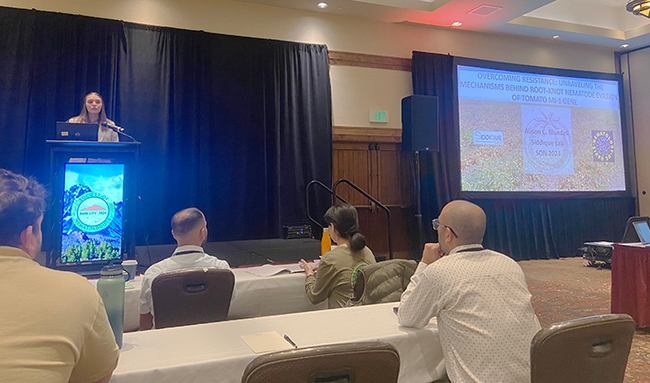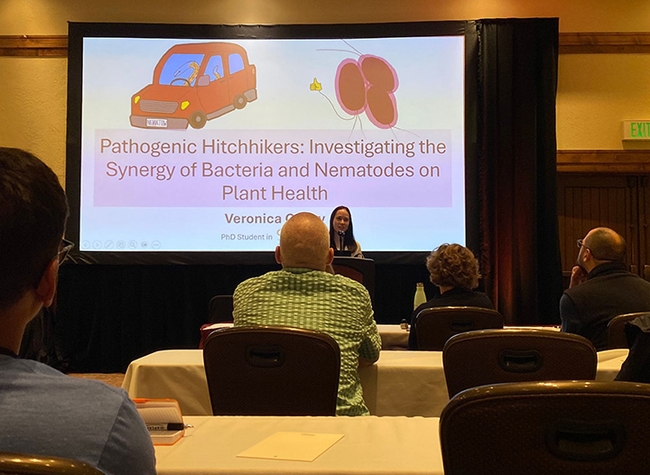Nematodes are where it's at!
Two UC Davis nematology doctoral students were invited to give research presentations at the international Society of Nematologists' conference in Park City, Utah and they excelled.
Meet the two young women: Alison Blundell, a doctoral candidate who was invited to compete in a 12-minute student oral competition to discuss her research on root-knot nematodes, and doctoral student Veronica Casey, invited to share her research on "Pathogenic Hitchhikers."
Their major professor, Shahid Siddique, encourages his students to participate in the Society of Nematologists (SON), an international organization that advances the science of nematology in both its fundamental and economic aspects.
Blundell, who anticipates receiving her doctorate in 2026, won second place in the international competition with her presentation, “Overcoming Resistance: Unraveling the Mechanisms Behind Root-Knot Nematode Evasion of Tomato Mi-Gene.” She received a $250 prize.
Blundell researches plant-parasitic nematodes specifically root-knot nematodes, and their molecular mechanism to defend against plant immune systems. In her abstract, she wrote: "Root-knot nematodes (RKNs) are among the most devastating pathogens of crops, causing substantial yield and economic losses worldwide. These parasitic organisms can infect over a hundred different plant species and can evade plant defense mechanisms by secreting a concoction of effectors. For decades, the Mi-1 resistance gene has been effective in detecting and inhibiting RKNs in tomatoes. However, the underlying mechanisms by which Mi-1 detects these pathogens remain largely unknown. In recent years, resistance-breaking populations have emerged in both greenhouse and field settings, posing a threat to the potency and effectiveness of the Mi-1 gene and, consequently, the tomato industry. "
"We used two strains of M. javanica, one strain VW4, which is recognized by Mi-1, and another strain, VW5, which was selected from VW4 and can overcome resistance mediated by Mi-1," Blundell explained. "Utilizing the newly constructed reference genome for M. javanica (VW4), we compared genomes of VW4 and VW5 and identified an approximately 50 kb region that is present in VW4 but missing in VW5. This missing region contains seven protein-coding genes, three of which encode putative effectors and are currently being tested as potential avirulence genes for Mi-1."
"In addition, we have conducted a series of infection assays on different host plants lacking Mi-1, and the results revealed a significantly lower egg count in VW5 when compared to VW4. We plan to expand these assays by testing additional M. javanica resistance-breaking strains collected from fields all over California to determine if this trade-off is consistent across other strains. Overall, our results suggest that although VW5 can overcome Mi-1, there is a trade-off in the form of compromised reproduction. This research helps to better understand the mechanism and components of Mi-1 and develop strategies for addressing resistance-breaking populations."
Pathogenic Hitchhikers
Doctoral student Veronica Casey delivered her invited presentation on “Pathogenic Hitchhikers: Investigating the Synergy of Bacteria and Nematodes on Plant Health.”
a"In the vast scope of soil ecology, plant-parasitic nematodes can forge alliances with other microbial adversaries, such as the disease complex formed between nematodes and bacterial wilt-causing Ralstonia spp.," Casey wrote in her abstract. "These disease complexes exacerbate disease symptoms and yield losses. Plant-parasitic nematodes are microscopic roundworms that cause approximately $100 billion in yield loss a year, and most of the damage is attributed to root-knot nematodes (RKNs; Meloidogyne spp.). Bacterial wilt is caused by multiple Ralstonia species, namely Ralstonia pseudosolanacearum, R. solanacearum, and R. sygzii that enter the plant's roots to colonize its vascular system. Prior to Ralstonia infection, RKN infection may facilitate bacterial disease by increasing access to the vascular tissue."
"However, little research has been conducted to elucidate the molecular details of this interaction," Casey pointed out. "Previous reports of RKN and Ralstonia spp. in the field hypothesized that the infection was due to root wounding and physiological changes. In this study, I will determine the nature of the interaction between Ralstonia and nematodes at both ecological and molecular levels. This research project will explore the hypotheses that 1) Ralstonia adheres to the cuticle of nematodes using specialized appendages called pili and 2) de novo xylem formation in the galls increases Ralstonia transport into the plant. A common strategy for preventing nematode infection is by using resistant plant cultivars."
"However, resistance-breaking nematode populations have arisen and we plan to utilize resistance-breaking nematodes, which are most likely to interact with bacterial wilt in the field," Casey noted. "This presentation will report on the attachment and greenhouse experimental results of the RKN-Ralstonia complex. The escalation of climate change is leading to increased instances of pathogenicity; therefore, it is crucial to uncover disease complexes which can have monumental consequences on food security. A meticulous study into the nematode and Ralstonia disease complex will support the management of these damaging pathogens across the world."
Blundell and Siddique also delivered invited presentations in the illustration workshop. Blundell gave her presentation on "Become an Illustrator Mender Simply by Using BioRender," and Siddique, "Doodle Your Data: Adobe Illustrator for Nematodes."
Other lab mates from the Siddique lab also participated in the SON meeting. (See news story). In the ecology session, doctoral candidate Chris Pagan participated from the UC Davis lab of distinguished professor Steve Nadler, former chair of the Department of Entomology and Nematology. Pagan's presentation: "Nematode Community Structure in the Rhizopsheres of Southern California Creosote (Larrea trientata).”
Of note, Blundell and Casey were among the four graduate students from the Siddique lab who received travel awards. Blundell won a Corteva award and Casey, a Certis award. Also receiving travel awards wer Ching-Jung Lin, a Bayer CropScience award and Romnick Latina, a N. A. Cobb Foundation award.
Honorary Member. At the 2024 conference, UC Davis distinguished professor emeritus Howard Ferris was selected a Honorary Member, the highest award that SON offers. (Feature story pending; wait 'til you hear his exciting life story!)
UC Davis nematologists are already looking forward to the next annual meeting: July 13-17 in Victoria, British Columbia, Canada. Meanwhile, you can chat one-on-one with them at the annual UC Davis Biodiversity Museum Day, usually held in February on the UC Davis campus. It traditionally featuring a dozen or so UC Davis museums. Student nematologists are spotlighted on the current website.
Attached Images:

Doctoral candidate Alison Blundell delivering her award-winning presentation in the 12-minute student competition at the international Society of Nematologists. She won second place. (Photo by Veronica Casey)

Doctoral student Veronica Casey of the Siddique lab delivering an invited presentation on “Pathogenic Hitchhikers: Investigating the Synergy of Bacteria and Nematodes on Plant Health.”